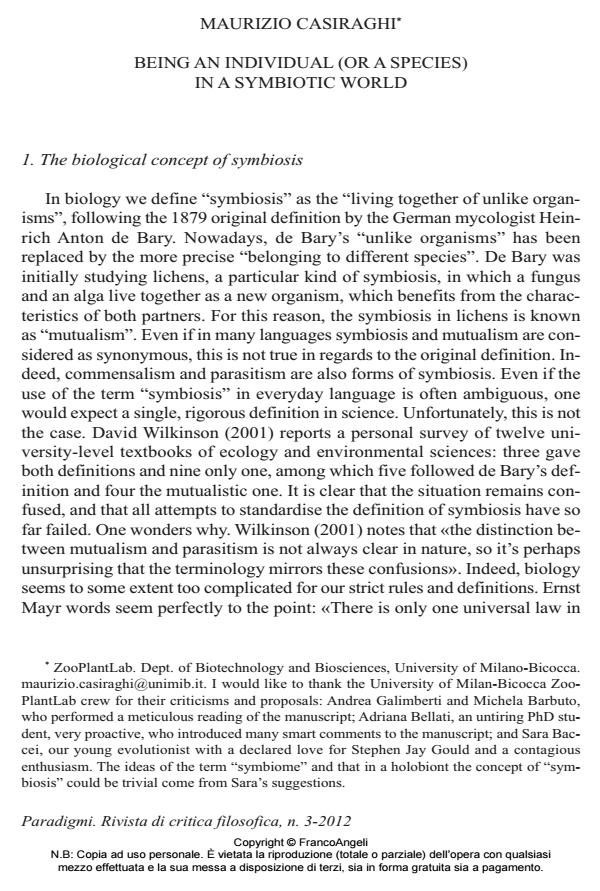Being an Individual (or a Species) in a Symbiotic World
Journal title PARADIGMI
Author/s Maurizio Casiraghi
Publishing Year 2012 Issue 2012/3
Language Italian Pages 11 P. 59-69 File size 96 KB
DOI 10.3280/PARA2012-003005
DOI is like a bar code for intellectual property: to have more infomation
click here
Below, you can see the article first page
If you want to buy this article in PDF format, you can do it, following the instructions to buy download credits

FrancoAngeli is member of Publishers International Linking Association, Inc (PILA), a not-for-profit association which run the CrossRef service enabling links to and from online scholarly content.
Symbiosis is the tight relationship between two or more species that are living together. In many cases the relationship is obligate, a situation in which we have to face some terminological problems. If the two symbionts are, in some way, forced to live together, what is the biological entity resulting from the relationship? A common way to think is to consider the biggest organism, usually defined as host, the individual or the species (according to the taxonomic rank taken into account). However, is this correct? Recent studies clearly underline that the unit of selection is not the host only, but the sum of all the organisms involved in the symbiosis. But if we evolve as a community of organisms, what is an individual or a species? To answer these questions it is necessary to incorporate Lamarckian mechanisms in Darwinian theory of evolution. Time is arrived for a real integration of symbiosis in the evolutionary studies, with all the consequences that are following. Parole chiave: Comunità di organismi, Evoluzione, Individuo, Specie, Simbiosi, Untà selettiva.
Keywords: Community of organisms, Evolution, Individual, Species, Symbiosis, Unit of selection.
- Morphology, ultrastructure, genomics, and phylogeny of Euplotes vanleeuwenhoeki sp. nov. and its ultra-reduced endosymbiont “Candidatus Pinguicoccus supinus” sp. nov. Valentina Serra, Leandro Gammuto, Venkatamahesh Nitla, Michele Castelli, Olivia Lanzoni, Davide Sassera, Claudio Bandi, Bhagavatula Venkata Sandeep, Franco Verni, Letizia Modeo, Giulio Petroni, in Scientific Reports 20311/2020
DOI: 10.1038/s41598-020-76348-z - Life With or Without Names M. Casiraghi, A. Galimberti, A. Sandionigi, A. Bruno, M. Labra, in Evolutionary Biology /2016 pp.582
DOI: 10.1007/s11692-016-9384-5
Maurizio Casiraghi, Being an individual (or a species) in a symbiotic world in "PARADIGMI" 3/2012, pp 59-69, DOI: 10.3280/PARA2012-003005